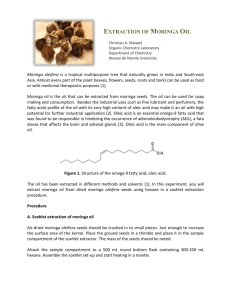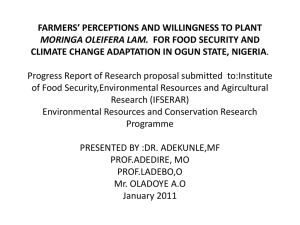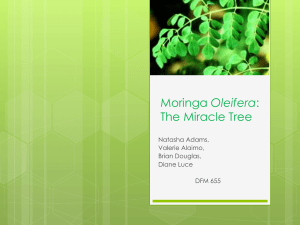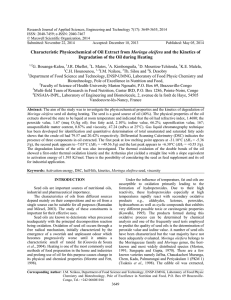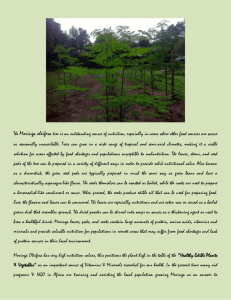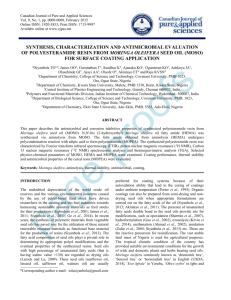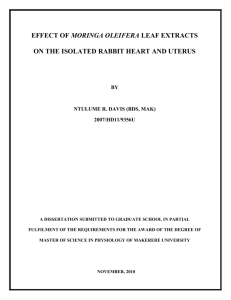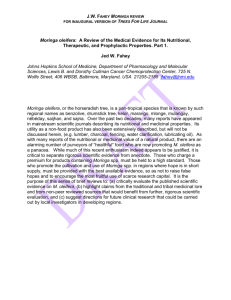Moringa oleifera A NEW SOURCE OF OLEIC ACID
advertisement
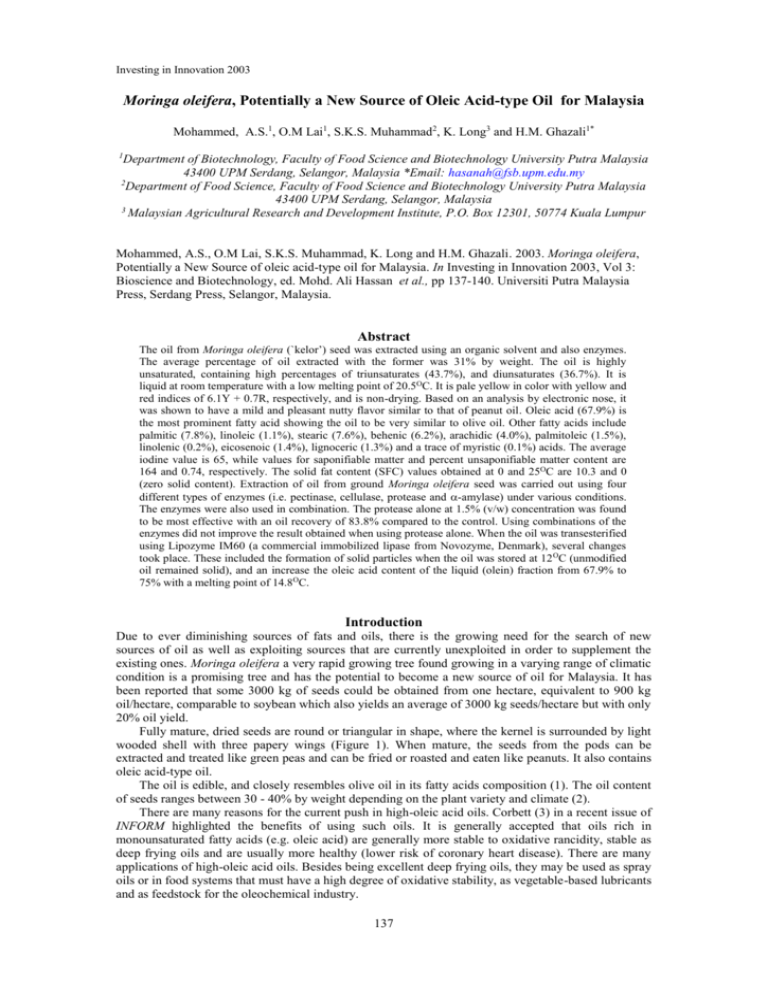
Investing in Innovation 2003 Moringa oleifera, Potentially a New Source of Oleic Acid-type Oil for Malaysia Mohammed, A.S.1, O.M Lai1, S.K.S. Muhammad2, K. Long3 and H.M. Ghazali1* 1 Department of Biotechnology, Faculty of Food Science and Biotechnology University Putra Malaysia 43400 UPM Serdang, Selangor, Malaysia *Email: hasanah@fsb.upm.edu.my 2 Department of Food Science, Faculty of Food Science and Biotechnology University Putra Malaysia 43400 UPM Serdang, Selangor, Malaysia 3 Malaysian Agricultural Research and Development Institute, P.O. Box 12301, 50774 Kuala Lumpur Mohammed, A.S., O.M Lai, S.K.S. Muhammad, K. Long and H.M. Ghazali. 2003. Moringa oleifera, Potentially a New Source of oleic acid-type oil for Malaysia. In Investing in Innovation 2003, Vol 3: Bioscience and Biotechnology, ed. Mohd. Ali Hassan et al., pp 137-140. Universiti Putra Malaysia Press, Serdang Press, Selangor, Malaysia. Abstract The oil from Moringa oleifera (`kelor’) seed was extracted using an organic solvent and also enzymes. The average percentage of oil extracted with the former was 31% by weight. The oil is highly unsaturated, containing high percentages of triunsaturates (43.7%), and diunsaturates (36.7%). It is liquid at room temperature with a low melting point of 20.5OC. It is pale yellow in color with yellow and red indices of 6.1Y + 0.7R, respectively, and is non-drying. Based on an analysis by electronic nose, it was shown to have a mild and pleasant nutty flavor similar to that of peanut oil. Oleic acid (67.9%) is the most prominent fatty acid showing the oil to be very similar to olive oil. Other fatty acids include palmitic (7.8%), linoleic (1.1%), stearic (7.6%), behenic (6.2%), arachidic (4.0%), palmitoleic (1.5%), linolenic (0.2%), eicosenoic (1.4%), lignoceric (1.3%) and a trace of myristic (0.1%) acids. The average iodine value is 65, while values for saponifiable matter and percent unsaponifiable matter content are 164 and 0.74, respectively. The solid fat content (SFC) values obtained at 0 and 25OC are 10.3 and 0 (zero solid content). Extraction of oil from ground Moringa oleifera seed was carried out using four different types of enzymes (i.e. pectinase, cellulase, protease and -amylase) under various conditions. The enzymes were also used in combination. The protease alone at 1.5% (v/w) concentration was found to be most effective with an oil recovery of 83.8% compared to the control. Using combinations of the enzymes did not improve the result obtained when using protease alone. When the oil was transesterified using Lipozyme IM60 (a commercial immobilized lipase from Novozyme, Denmark), several changes took place. These included the formation of solid particles when the oil was stored at 12 OC (unmodified oil remained solid), and an increase the oleic acid content of the liquid (olein) fraction from 67.9% to 75% with a melting point of 14.8OC. Introduction Due to ever diminishing sources of fats and oils, there is the growing need for the search of new sources of oil as well as exploiting sources that are currently unexploited in order to supplement the existing ones. Moringa oleifera a very rapid growing tree found growing in a varying range of climatic condition is a promising tree and has the potential to become a new source of oil for Malaysia. It has been reported that some 3000 kg of seeds could be obtained from one hectare, equivalent to 900 kg oil/hectare, comparable to soybean which also yields an average of 3000 kg seeds/hectare but with only 20% oil yield. Fully mature, dried seeds are round or triangular in shape, where the kernel is surrounded by light wooded shell with three papery wings (Figure 1). When mature, the seeds from the pods can be extracted and treated like green peas and can be fried or roasted and eaten like peanuts. It also contains oleic acid-type oil. The oil is edible, and closely resembles olive oil in its fatty acids composition (1). The oil content of seeds ranges between 30 - 40% by weight depending on the plant variety and climate (2). There are many reasons for the current push in high-oleic acid oils. Corbett (3) in a recent issue of INFORM highlighted the benefits of using such oils. It is generally accepted that oils rich in monounsaturated fatty acids (e.g. oleic acid) are generally more stable to oxidative rancidity, stable as deep frying oils and are usually more healthy (lower risk of coronary heart disease). There are many applications of high-oleic acid oils. Besides being excellent deep frying oils, they may be used as spray oils or in food systems that must have a high degree of oxidative stability, as vegetable-based lubricants and as feedstock for the oleochemical industry. 137 A.S Mohammed, et al Moringa oleifera, potentially a new source of oleic acid-type oil for Malaysia Figure 1 M. oleifera seed Usually solvents are used to extract fats and oils. Solvents, however, are not environmentally friendly. Enzymes, on the other hand, are green catalysts, and are often used to improve the efficiency of oil extraction. Rosenthal et al (4) have reviewed the use of enzymes in the extraction of oil, protein, and other components from oil-containing seeds and fruits. This technology has been developed to extract oil on a laboratory and pilot scale from many oil-bearing materials. In this paper results of a study done on characterization of the oil and the effects of using enzymes on the extraction process are presented. Methodology Mature Moringa oleifera seeds were collected from neighborhood gardens and fences around University Putra Malaysia and surrounding areas where the plant is found growing in abundance. Seeds collected are sun dried and stored under cool dry storage until needed. Solvents and chemicals used were all of analytical grade obtained from BDH laboratories England. All enzymes used were donated by Novozymes Bagsvaerd Denmark. Using a Soxhlet apparatus, oil was extracted from ground Moringa seed and several analyses were carried out. Using standard procedures compiled in PORIM test methods (5), the oil was analyzed for iodine, saponification values and unsaponifiable matter and free fatty acids contents. The color of oil was determined using Lovibond tintometer Model E (Salisbury, England). The results obtained were recorded as Lovibond yellow and red indices. The fatty acid composition was determined using a gas chromatograph (Shimadzu, Japan), fitted with a 2 m x 1/8 stainless steel column containing BPX70. Individual fatty acid methyl esters peaks were processed using a Shimadzu (Japan) C-R6A chromatopack integrator (6). The triglyceride profile was obtained using a high performance liquid chromatogragh (Shimadzu LC-10) equipped with an SCL-10A (Shimadzu, Japan) system controller and a RID-6A refractive index detector (7). The profile obtained was compared to standards for identification. The thermal properties of oil were investigated by differential scanning calorimetry (Perkins-Elmer model DSC-7) (8). A wideline NMR was used to determine the solid fat content (SFC) (9). Flavor was evaluated by comparison with peanut oil using an electronic nose. Experiments were carried out to compare oil yield from enzyme-treated samples with untreated samples, as described by Tano-Debrah and Ohta (10). The enzymes used were a neutral protease, amylase, pectinases and cellulases. These enzymes were all commercial. The enzymes were used separately and in combination of varying concentrations (0, 0.5, 1, 1.5 % v/w), incubation temperatures (45 and 60OC) and time (0-24h) Fifteen grams (dry weight) of ground seeds were mixed with 6 parts v/w of distilled water and the paste was boiled gently for 5 minutes. The mixture cooled to 30 OC, the pH adjusted to 6.5 and an enzyme was then added at the required concentration. A mixture without addition of enzyme served as the control. The paste were stirred thoroughly and incubated at 45 or 60OC for 2, 4, 8, 12, and 24 hours. The amount of oil extracted was measured by weighing the dried oil and results were expressed as a percentage of the total weight of sample used during the extraction. Results obtained for each enzyme treatment at different concentration and incubation temperature were used to calculate the percent oil yield based on the initial total oil in the sample estimated using the Soxhlet method (11). Percent oil yield obtained for various enzyme treatment were compared. Modification of the oil was carried according to Ghazali et al. (6) by reacting a sample of the oil with Lipozyme IM60, a commercial available immobilized lipase. The reaction was carried out over a period of 12 h at 40OC with shaking. Samples were stored at 10OC prior to fractionation into liquid fraction (olein) and solid fraction (stearin). The effect of enzyme reaction was monitored by way of triglyceride profiling, fatty acid composition and melting behaviour. 138 Investing in Innovation 2003 Results and Discussion There are many known examples of high-oleic acid oils. These are olive oil (80%), high-oleic canola oil (75%), high-oleic sunflower oil (>80%) and high-oleic safflower oil (77%) (3). M. oleifera seed oil has the potential to become one of these highly valuable oils. Results obtained show that the average oil content of Moringa oleifera seed was about 31% by weight. The fatty acid composition was similar to those obtained by Ferrao and Ferrao (1) and Dahot and Memon (12), and showed that Moringa seed oil is rich in oleic acid (67.9%). Other fatty acids present are myristic (0.1%), palmitic (7.8%), palmitoleic acid (1.5%), stearic (7.6%), linoleic (1.1%), linolenic (0.2%), arachidic (4.0%), eicosenoic (1.5%), behenic (6.2%), and lignoceric (1.3%). In comparison, palm olein, a commodity of high economic importance comprises ~45% oleic acid only. The triglyceride profile (Figure 2) by HPLC analysis shows that the oil is highly unsaturated containing 80.4% polyunsaturates (43.7% triunsaturates and 36.7% diunsaturates) and 5.3% monounsaturates. The major triglycerides present are OOO (36.7%), POO + SOL (12.4%), SOO (11%) and OOA (7.7%), where O, P, S, L and A are oleic, palmitic, stearic, linoleic and arachidic acids, respectively. Differential scanning calorimetric (DSC) analysis showed that the oil has a low melting point of 20.5OC (slip melting point of 19ºC). The solid fat content (SFC) values obtained at 0 and 25OC are 10.3 and 0 (zero solid content), respectively. Iodine value is 65, which accounts for its nondrying nature. The oil stays for a long time without becoming rancid. It has a saponifi-cation value of 164, and because of this, the use of the oil for soap making has been documented (13, 14). The unsaponifiable matter content is 0.74 %. The oil is pale yellow in color with 6.1Y yellow and + 0.7R red index values. Thus, the high oleic acid content of the oil coupled with its highly unsaturated nature, low peroxide value (stable to oxidative degradation), and its pleasant nutty flavor may qualify the oil for use in food industry. The optimal reaction conditions for oil recovery were found to be 1.5 % (v/w) enzyme in a paste comprising of 15g of ground Moringa oleifera seed in 100mL of distilled water, pH 6.5 and incubation time and temperature of 45 OC and 24 h, respectively. In all the different sets of conditions, a commercial protease was found to be the most effective with the highest percent recovery (83.8%) compared to the control. The value slightly increased when a combination of the four enzymes was used. In general, all the samples pre-treated with the three enzymes and their combination gave higher oil yield than the control. Transesterification of the oil using lipase resulted in changes including formation of solid particles when the oil was stored at 12OC (unmodified oil remained solid), and when these solids were removed the residual liquid (olein) fraction has an oleic acid content of 75% and lower melting point of 14.8 OC. OOO Figure 2 Triglyceride profile of M. oleifera oil Conclusion Although there is currently limited application and usage of this oil in food preparation in Malaysia, it is edible and can be used as a new source to supplement existing sources of vegetable oil, especially as a source of the much sought-after high-oleic acid oil. Also, because of its similarities with olive oil, it can be used as a substitute to the expensive oil after some modifications. The presence of protease in an aqueous (the use of solvents can be hazardous) extraction medium had successfully improved oil recovery. Furthermore, there is the possibility of using enzymatic modification to improve fluidity of the oil such that it may become highly desirable to the food and culinary industries. 139 A.S Mohammed, et al Moringa oleifera, potentially a new source of oleic acid-type oil for Malaysia Acknowledgements This research project was funded by a Ministry of Science, Technology and the Environment research grant (No. 09-02-04-004 BTK/ER/008) awarded to Hasanah M. Ghazali. References 1. 2. 3. 4. 5. 6. 7. 8. 9. 10. 11. 12. 13. 14. Ferrao, A.M.B and J.E.M. Ferrao. 1970. Agronomia Angolana (Luanda) 30: 3-16. Jamieson, G.S. 1939. Oil and Soap 16: 173-174. Corbett, P. 2003. Inform 18(8): 480-481. Rosenthal, A., D.L Pyle, and K. Niranjan. 1996. Enzyme and Microbial Technology 19: 402-420. PORIM . 1995. PORIM test methods Malaysia: Palm Oil Research Institute of Malaysia, Ministry of Primary Industries. Long, K., H.M. Ghazali, A. Ariff and C. Bucke. 1997. Journal of American Oil Chemists’ Society 74(9): 1121-1128. Ghazali, H.M., S. Hamidah, and Y.B. Che Man. 1995. Journal of American Oil Chemists’ Society 72(6): 633-639. Lai, O.M., H..M. Ghazali and C.L. Chong. 1998. Journal of American Oil Chemists’ Society 75(7): 881886. Liew, M.Y.B., H.M. Ghazali, O.M. Lai, A.M. Yazid, and K. Long. 2001. Food Chemistry 72: 447-454. Tano-Debrah, K and Y. Ohta. 1995. Journal of American Oil Chemists’ Society 72(2): 251-256. AOAC. 1984. In Methods of analysis of the Association of Official Analytical Chemists. 14th edition Horowitz W. Ed. Washington D.C. Dahot, M.U and A.R. Memon. 1985. Journal of Pharmacy 20(4): 75-79. Chopra, R.N., R.L Badhwar and S. Ghosh. 1965. Poisonous plants of India 1: 412-427. Simmonds, P.L. 1954. Commercial Products of the Vegetable Kingdom, T.F.A. Day London. 140
